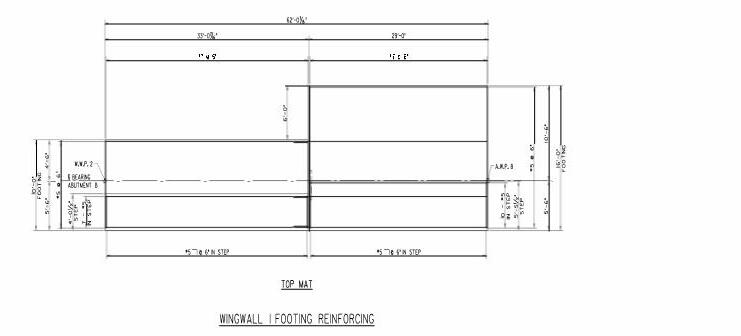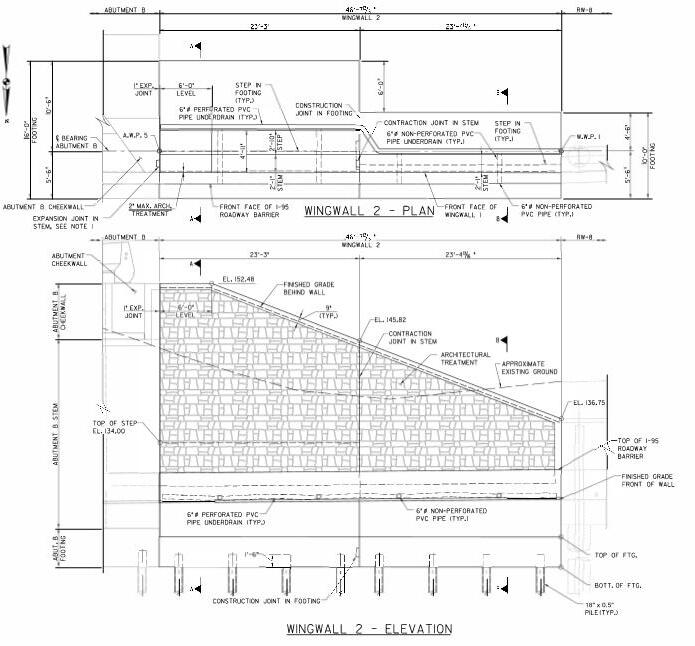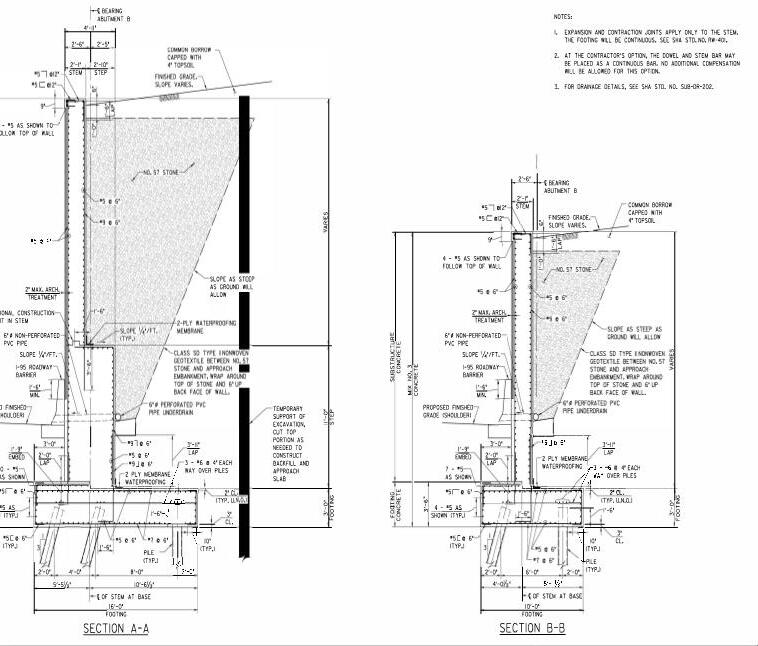
11 minute read
About the Author
Roy Huemer, CPE Garden State - 26 Roy@huemerllc.com
His career in construction began in 1986 and he currently trains estimators as well as consulting contractors in many fields of construction, educating them in the art of estimating and cost estimating.

He began his career in construction as a laborer working for a residential home builder. He later worked for civil design engineers as a draftsman. There he acquired skills in construction survey which led him to the field of heavy highway construction.
He joined the estimating group of contractors active in the New Jersey heavy civil construction field. Over the next 20 years, he gained the knowledge and experience to work, estimate, and manage heavy civil construction. He has also trained estimators in the general contracting, electrical, and mechanical fields as well as many other contracting disciplines.
using surveyed layout information. The pile will be lowered to the ground, the hammer will be lowered upon the end of the pile, and the pile will be driven into the ground.
Once the pile is driven to the expected depth, the exposed top will be cut off. A fabricated rebar cage that will function as a connection between the pile and the proposed structure will then be installed and, in this case, the pile will be filled with concrete to provide added strength.
Types and Methods of Measurement
The following are the typical units one would encounter:
EA = Each – Used for a count of specific items i.e., number of piles, points, splices
LF = Linear Feet – Used for lengths of components i.e., pile, rebar
FT or ‘ = Feet – Used for length as well as elevation i.e., top of the pile, tip of the pile
IN or “ = Inches – Used for length typically shorter than one foot i.e., rebar clearances, pile wall thickness
CY = Cubic Yard – Used for the quantity of materials i.e., concrete, sand
LB = Pound – Used for weight i.e., crane capacity for lifting
LS = Lump Sum – Used for quantification of complex operations to sum them into a single value
TN = Ton or 2,000 pounds i.e., maximum crane capacity
Specific Consideration Factors
Initial Considerations
The information needed to estimate accurate and detailed costs for the construction of CIP piles would begin to be derived from construction documents provided by a licensed design engineer. These documents would consist of plans and specifications that would include where the pile(s) would be located, into what material the pile will be driven, pile capacity, what forces would be allowed to be exerted upon the pile, pile diameter, pile wall thickness, type of steel, pile top elevation(s), pile tip elevations(s), whether splices are allowed and the methods with which a splice would be made, the need for a point or end plate, the need to fill the pile and with what material, whether that material is reinforced, whether the pile is coated and if so with what material.
The methods of measurement and payment can significantly impact the pricing the estimator must calculate in order to suitably respond to the proposal. In many cases, due to the volatility of final pay quantities, some project owners will provide line items for the work in the following manner:
• Mobilize Pile Driving Equipment
• Furnish Materials for Test Piles of XX size
• Install Test Piles of XX size
• Test Piles for capacity
• Furnish Materials for Production Piles of XX size
• Install Production Piles of XX size
Should this level of detail not be able to be incorporated into the contract in some form or other, the estimator’s risk analysis will have to incorporate said volatility of the quantities of work. It would behoove the estimator to encourage the proposal’s sponsor to incorporate these line items in order to not incur substantial costs due to the associated risks.
In that the subsurface materials can vary significantly in composition, the length of a pile can vary wildly. For example, bedrock can exist in one pile location at an elevation 50 feet below grade. Five feet in any direc- tion an underground “cliff” can exist. This is where the bedrock drops or rises substantially, and the pile driven in that location can be much longer or shorter than anticipated.
Without the level of detail listed above, pricing the work will be challenging. For example, should the production pile item consist of supply and installation, and the quantity installed, being the basis of payment, should run shorter than expected, the contractor runs the risk of having compensation reduced while expense remains the same. Should the estimator account for an anticipated underrun of quantity and, in fact, the quantity overruns, the realized compensation may not cover the actual costs as well as overhead and profit for the work completed.
Equipment Selection
Many factors come into consideration when selecting equipment. It would all begin with the results of the Test Pile (discussed in the Miscellaneous Pertinent Information section below) that would dictate the order length of pile(s) and the hammer with which the pile would be driven. Both the pile length and hammer size and type would then be used to select the length of leads in which the pile and hammer would be mounted to ultimately drive the pile. All of this is used to subsequently choose the crane boom length that would place the pile hammer and leads on the proposed location and support the hammer within the leads while lifting the pile into driving position. This can be calculated as follows:
Design pile length + waste length + variable length to allow for mill rolling = total pile length
Total pile length + hammer length + rigging for hammer = minimum lead length
Minimum lead length + additional lead to achieving manufactured lengths = total lead length
Total lead length + rigging for assembly + increase for radius from a crane (the hypotenuse of the triangle) = maximum crane boom length.
Once the maximum crane boom length is determined, one can choose the crane from manufacturers’ catalogs that would provide crane sizes that would carry the appropriately sized boom length. Next, the capacity of the crane at the appropriate radius must be calculated by the following methodology:
Total lead weight + total pile hammer weight + total pile weight + rigging = total load.
Once the total load is calculated, the radius from the center of the crane to which the pile would be driven is then compared to the manufacturer’s load chart.
The total load must be less than the maximum capacity, at the maximum radius of driving in conjunction with the required boom length in order to safely lift the load according to the manufacturer of the crane. See the reference section for a typical crane used in this type of work for the details mentioned herein. It should be noted various agencies have specific safety factors that are placed upon these calculations and even though the manufacturer’s data may show safe lifting conditions, a multiplier of two times, three times, or as much as five times may be mandated.
Soil Conditions
Soil borings should be incorporated into the contract documents and should be performed in sufficient quantity and location to accurately describe the subsurface conditions on the site. Soil Borings are frequently taken with the use of an auger and a “spoon”. The auger would drill down into the soil, allowing for the retrieval of samples of the soil at different levels for classification. The spoon is a device that would be placed within the auger and blows of a certain force upon the spoon would determine the cohesivity of the soil and its ability to withstand force.
Site soil conditions can vary wildly, even within a relatively small area. Bedrock can range from depths of 5 feet below the surface to 100 feet below the surface within a 20-foot stretch of ground. Soil sampling can show a layer of soil that takes 3 blows to drive an auger 6 inches deep and in a stratum 5 feet below that, it could take 50 blows to drive the sample spoon 2 inches.
Specific Site Conditions
Existing site conditions as well as project staging can severely impact the productivity of the construction of these piles. Should overhead obstructions of any kind exist, this will limit the length of the section of the pipe pile that may be installed. This will subsequently impact the amount of work to be completed to install the pile.
Labor Availability
In some areas of the country, labor unions are in control of the people that will install these piles. If a project of significant scope is underway in the same area as the project being bid on, the availability of labor may be an issue. Further, across the industry, contractors are finding it increasingly more difficult to fill job openings with skilled personnel.
This can significantly impact productivity regardless of what the company’s history of performance on the scope of work has been. The potential lack of experienced personnel must be incorporated into produc- tivity expectations as the impact on costs can be significantly more than the material itself in some parts of the country.
Weather
Pile driving is one of those components of a project that can take place in the rain, snow, heat, and cold for the most part. However, certain parts of the county do have specific weather impacts that will affect daily productivity. Lightning storms and high winds are two of these types of factors that must be considered and incorporated into the productivity of the crew.
Value Engineering Potential
The types of piles are legion. The earliest piles were in the form of timber poles, simply placed in previously dug holes. Then stones in their natural state were piled in narrow holes to serve the same purpose. Following that, the stones were cut into shapes more suitable for stacking. Afterward following the ability to fabricate iron and steel, shapes were derived for many structural construction purposes, and some were found to be quite efficient as foundation support.
H-piles, pipe piles, Z-piles, U-piles, and many more shapes are currently in use. Many configurations combine the available shapes to serve various construction needs. To this day, pile construction evolves and improves.
Alternatives to the designed pile should always be considered. Dependent upon contract documents, pricing said alternative sometimes may be incorporated into the estimate. In this case, the cost savings, reflected in the project pricing, could easily win the job.
Overview of Cost and Markups
Labor
The labor costs in this estimate will be based upon New Jersey Prevailing Wage Determination, expiring in 2022 in addition to payroll taxes, workers’ compensation, and general liability.
Equipment
The equipment rates utilized are based on US Army Corps of Engineers document EP1110, dated 2020 escalated to today’s current rates. Ownership and operating costs will be combined.
Materials
Pricing is based upon recent information gathered from local suppliers.
Inderect Costs
Indirect costs such as on-site project management, safety, and job site facilities such as field offices, dumpsters, and sanitary facilities will be incorporated into the estimated costs via a percentage for Overhead and Profit.
Overhead
A generalized overhead for the estimate of 10% will be used to cover the costs of non-job-specific supervision, home office expenses, and other similar costs to the project. The actual value is company specific and can easily vary extensively and must be calculated for the specific company’s requirements. 10% shall be used for this example.
Profit
For this example, 10% will be utilized. All of these values would be dictated by each company bidding the work and should be derived by careful consideration and detailed mathematical backup.
Special Risk Considerations
Soils
The soil borings, when taken in sufficient quantity and depth, will give a detailed analysis of the materials through which the piles will be driven. Should insufficient boring information, i.e., lack of soil composition, gradation, density, and other characteristics, be provided the estimator takes on a substantial risk anticipating production.
Safety
Construction is inherently dangerous and pile driving is even more so. Fall protection, objects dropped from overhead, and unmarked utilities are just some of the considerations that must be addressed in a safety plan. The safety procedures set forth must be monitored and enforced to minimize the potential for injury on the site.
Scheduling
As piles are typically installed early in the construction sequence on new construction, conflicts with proposed work typically are not a significant issue. When this work is performed as a modification to existing structures, clearances for the equipment required to install this work must be examined in detail. A significant impact on this work will also be the relocation of existing overhead and underground utilities and the construction of new utilities in order to not impact the construction of these piles.
Ratios and Analysis
In that the plethora of variables regarding the construction of CIP piles preclude any consistent ratios for labor/equipment/material/productivity, the best source of cross-checking comes from the contractor’s own history.
This, of course, raises the chicken vs egg conundrum. To obtain production and cost data from one’s history, one must first construct the pile. To construct the pile, one must typically estimate the work. Without estimating and subsequently constructing the pile, history cannot be obtained. To combat this, an outside consultant well versed in the work required, region the work will be performed, labor market available, equipment required, and other aspects will be the best source of confirmation of costs.
Additionally, searching through public agencies’ published unit prices for contracts can be a valuable source of pricing confirmation. Typically, these public agencies will publish the unit prices provided by all bidders at some point.
Some agencies publish almost immediately after the bid opening while some publish only after the award of the project. Searching through the databases of unit prices for similar work in similar conditions will be a valuable guide to the estimator, provided due diligence regarding the pricing is performed.
Miscellaneous Pertinent Information
Test piles are the method by which a pile design would be confirmed on a project. That entails constructing a single pile per expected condition with the equipment, materials, and methodology anticipated. This paper will not be addressing said operation; however, the estimator should be aware the costs for these piles are markedly more than that for the production pile.
As witnessed by recent events, the volatility of material costs can significantly impact the price of the installed pile. From labor shortages due to pandemics or raw material availability due to global instability, the estimator must be aware of these cost impacts and do their best to incorporate those costs.
Dependent upon quantity, procuring the pipe pile material may be limited to time limits known as “mill rollings”. Typically, the length and quantity of piles required would need custom fabrication, which happens at certain times as decided upon by the manufacturers. This will have potentially substantial impacts on the schedule should the mill rolling not be conducive to meeting schedule requirements.
Steel Pipe Piles are manufactured at steel processing plants. These are limited in number and as such their
Details and Plans
Pile Detail location can impact costs directly. Should the plant and the project to which the piles are to be shipped be located on viable waterways, piles in excess of 100 feet in length could be barged to the project location. Should over-the-road travel be dictated, over-length, overweight, and travel periods can impact delivery dates, times, and costs.
Additionally, should over-the-road transport be required, the length of the pile to be transported will impact costs. Overlength or overweight permits as well as additional splicing will add costs and the relevant conditions must be analyzed to achieve the most economical outcome.
The pay quantity for this type of item constructed under the presumed specification is to the nearest rounded whole foot per unit installed. Pay quantity is the length of the pile that would be included in the calculation for compensation for the work. Some agencies will not pay for piles above grade yet are required for connection into the footing above while others will pay for all footage driven and cut off, whether incorporated into the structure or not. The calculations take these criteria into consideration.













